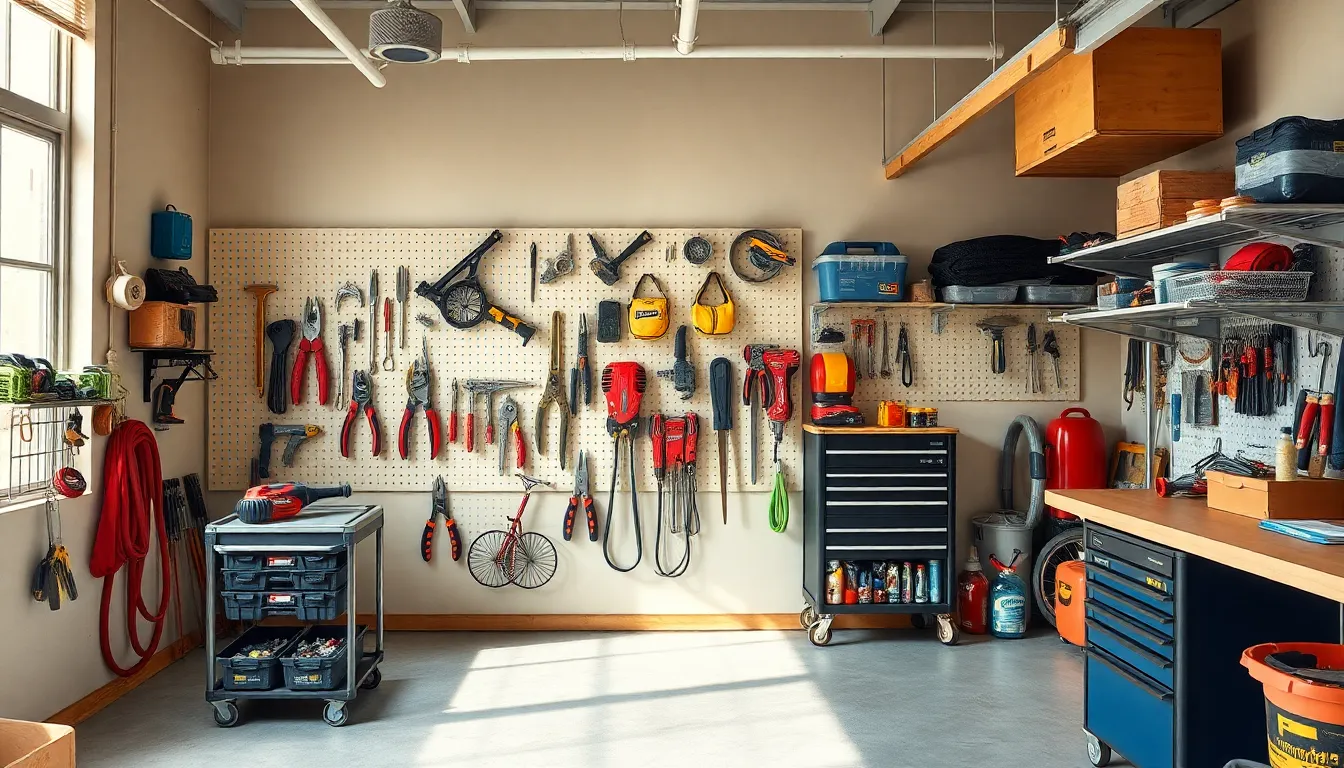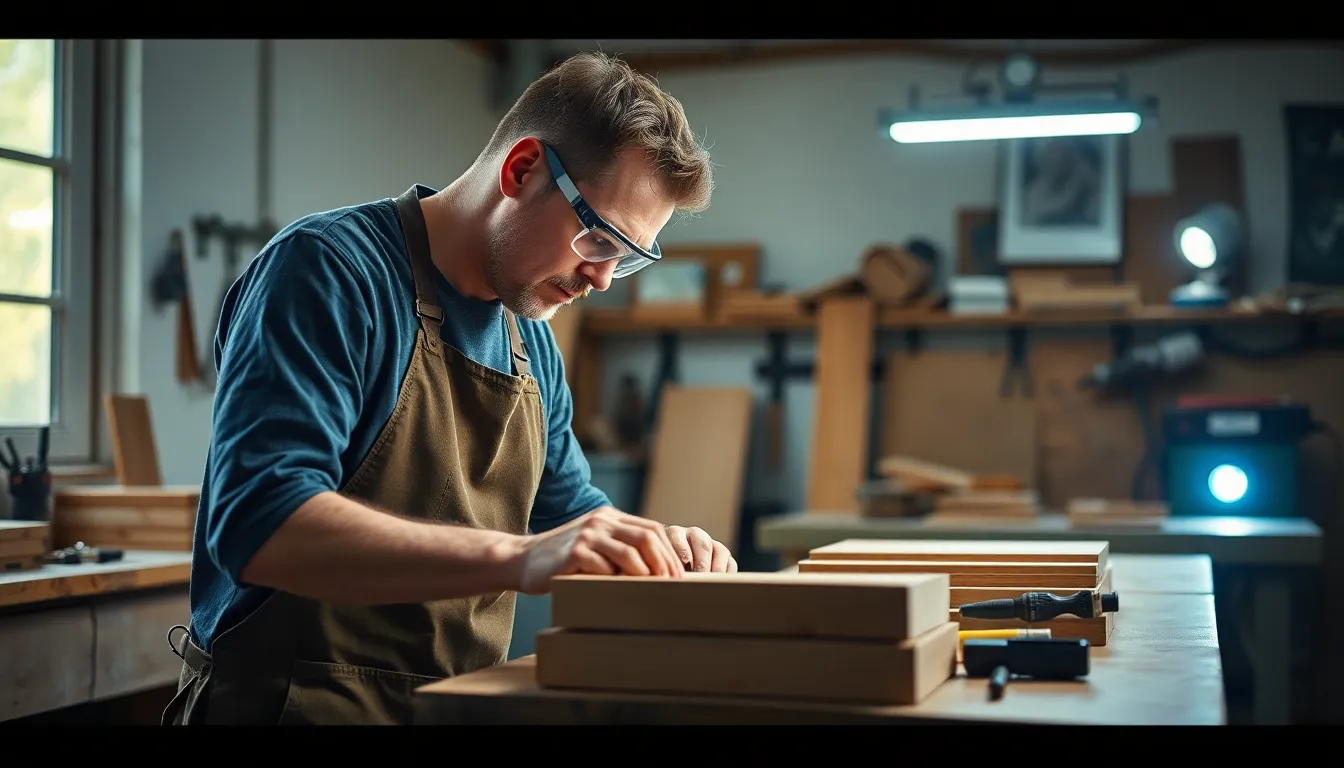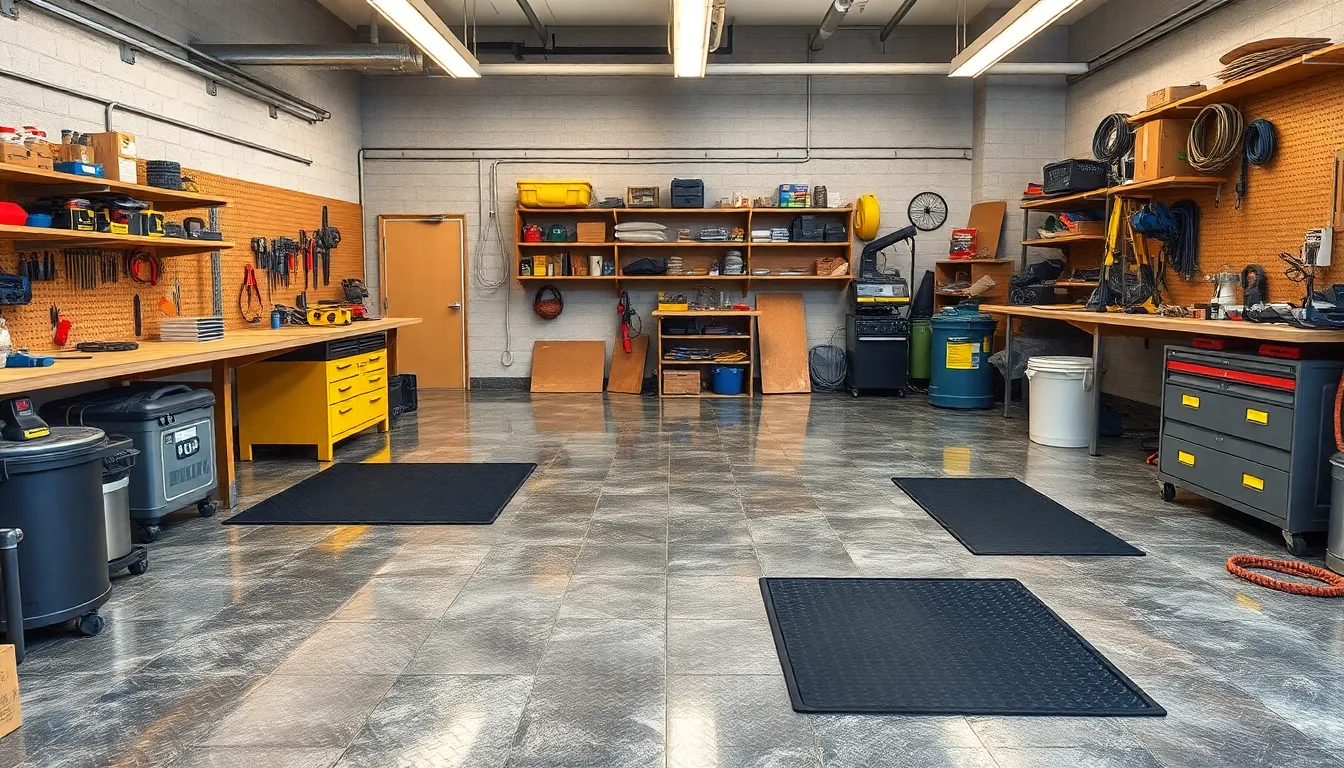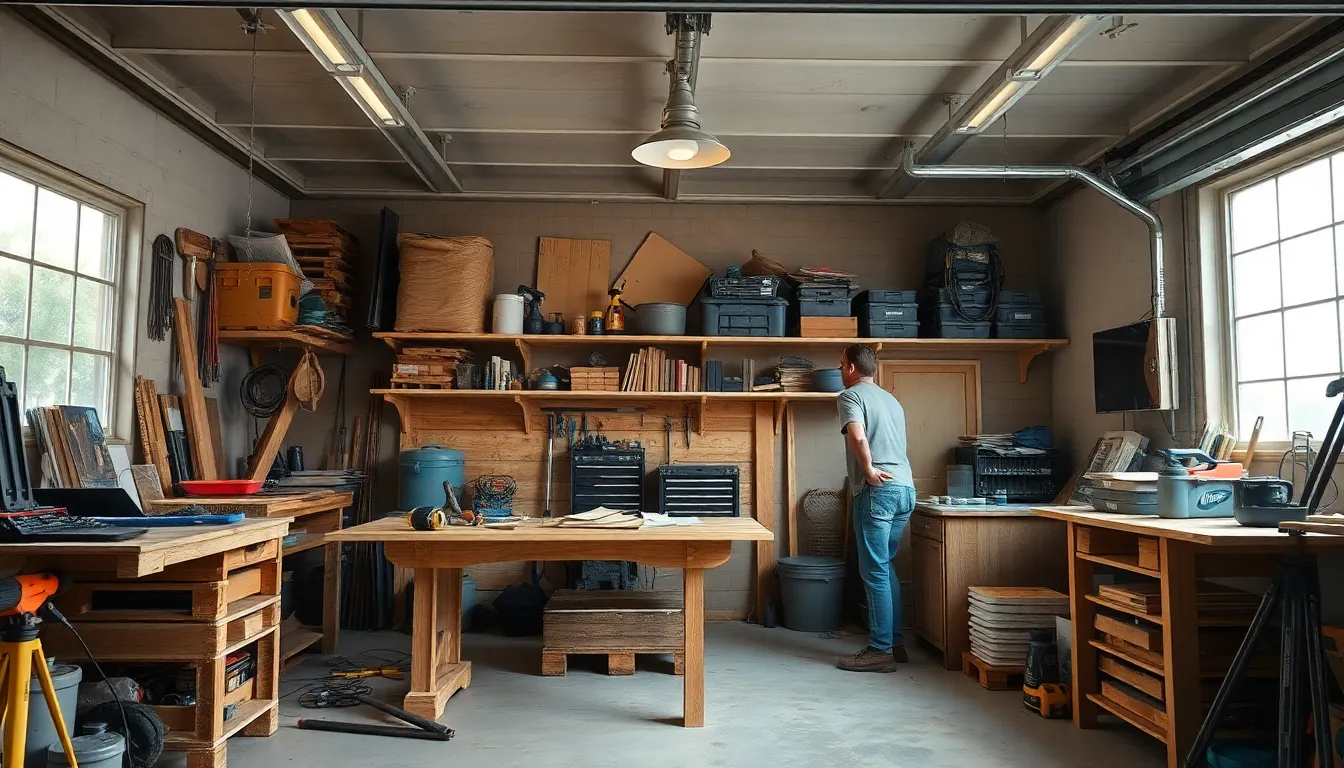We’ve all walked into workshops that felt more like cramped storage closets than productive workspaces. The difference between a functional workshop and an inspiring one often comes down to smart design choices that maximize both efficiency and creativity.
Whether you’re setting up your first workshop or redesigning an existing space, the right layout can transform how you approach your projects. From clever storage answers that keep tools within arm’s reach to lighting strategies that reduce eye strain during detailed work, every design decision impacts your productivity and enjoyment.
We’ll explore practical workshop design ideas that work for any budget and space size. These proven strategies help you create an organized environment where you can focus on what matters most – bringing your creative visions to life.
Creative Layout Solutions for Maximum Workshop Efficiency
Maximizing workshop efficiency requires strategic layout planning that transforms your workspace into a productivity powerhouse. We’ll explore three proven layout approaches that dramatically improve workflow and organization.
Open Floor Plan Configurations
Open floor plans create seamless movement between work areas while maximizing available square footage. We position major equipment along the perimeter walls to keep central floor space clear for large projects and material handling.
Strategic equipment placement includes placing table saws near electrical outlets, positioning workbenches perpendicular to windows for natural lighting, and locating dust collection systems against exterior walls for ventilation. Rolling tool carts bridge the gaps between stationary equipment, allowing us to bring tools directly to our work location.
Traffic flow optimization ensures we can move freely throughout the space without backtracking or handling around obstacles. We maintain 36-inch minimum walkways between major equipment and create clear sight lines across the entire workshop for safety monitoring.
Zone-Based Workshop Organization
Zone-based organization divides the workshop into dedicated areas for exact tasks, reducing setup time and improving focus. We typically establish four primary zones: cutting and preparation, assembly and finishing, storage and inventory, and inspection and packaging.
Dedicated work zones include a cutting station with all measuring tools and marking equipment, an assembly area with clamps and fasteners within arm’s reach, and a finishing zone with proper ventilation and lighting. Each zone contains its essential tools and supplies, eliminating time wasted searching for equipment.
Transition areas connect zones smoothly with mobile storage units and temporary staging areas. We use rolling workbenches that serve multiple zones and position frequently shared tools at zone boundaries for easy access.
Multi-Level Storage Integration
Multi-level storage systems use vertical space efficiently while keeping tools and materials easily accessible. We carry out wall-mounted storage, overhead systems, and under-bench answers to triple our storage capacity without expanding floor space.
Vertical wall systems include pegboard panels for hand tools, slat wall systems for adjustable storage, and wall-mounted cabinets for supplies and hardware. French cleat systems provide maximum flexibility, allowing us to reconfigure tool storage as project needs change.
Overhead storage answers accommodate seasonal items, bulk materials, and rarely used equipment using ceiling-mounted racks and pulleys. We install lumber racks above head height and use rope and pulley systems to easily retrieve heavy materials when needed.
Under-bench integration maximizes every square inch with pull-out drawers, swing-out tool panels, and mobile storage units that nest beneath work surfaces. Rolling tool chests fit perfectly under standard height workbenches while remaining easily accessible during projects.
Essential Storage Systems That Transform Workshop Spaces

Smart storage systems can revolutionize your workshop’s functionality and efficiency. We’ll explore three proven storage approaches that maximize space while keeping tools and materials easily accessible.
Wall-Mounted Tool Organization
Wall-mounted systems create immediate floor space while keeping tools within arm’s reach of your workspace. Pegboards offer the most flexibility, allowing you to position hooks, baskets, and holders exactly where you need them for tools of various sizes. Slatwall panels provide superior support for heavier tools and accessories, making them ideal for power tools and bulky equipment.
Custom shelving units above workbenches transform dead wall space into valuable storage real estate. Installing shelves along workshop walls creates dedicated spots for frequently used items, reducing the time you spend searching for essential tools. These systems keep your most important tools visible and organized, eliminating the frustration of digging through cluttered drawers.
Mobile Storage Cart Answers
Mobile storage carts bring unprecedented versatility to workshop operations by moving tools directly to your work area. Rolling these carts between different stations eliminates countless trips back and forth across your workshop, saving both time and energy. Multiple drawer configurations let you sort small parts, hardware, and hand tools into organized categories.
Bin storage systems on mobile carts work exceptionally well for projects requiring various fasteners, electrical components, or create supplies. Compact workshops benefit most from mobile answers since every square inch counts toward productivity. These carts adapt to changing project needs while maintaining organization throughout your workspace.
Overhead Storage Maximization
Overhead storage systems unlock valuable vertical space above workbenches and garage doors that often goes unused. Ceiling-mounted racks excel at storing bulky seasonal items like holiday decorations or materials you access less frequently. Platform systems create substantial storage capacity without interfering with your primary work areas.
Proper installation requires following manufacturer weight limits and safety recommendations to prevent accidents. Overhead answers keep floor space completely clear while preventing clutter from accumulating on work surfaces. Strategic placement of overhead storage ensures you can access stored items safely while maintaining an organized workshop environment.
Lighting Design Strategies for Optimal Workshop Visibility

Proper lighting transforms any workshop from a frustrating workspace into a productive environment where we can tackle projects with confidence. Strategic illumination choices directly impact our ability to work safely and efficiently throughout the day.
Natural Light Optimization Techniques
Assessing natural light patterns throughout the day helps us maximize this free illumination source. We should observe how sunlight enters our workshop at different times to understand where shadows fall and which areas receive direct light. Morning light typically comes from the east while afternoon sun streams in from the west.
Positioning workbenches near windows capitalizes on natural brightness during peak daylight hours. Strategic placement of our primary work areas takes advantage of the strongest natural light available. We can complement this natural illumination with artificial lighting that counterbalances any harsh shadows or dim spots.
Creating a harmonious lighting environment requires balancing natural and artificial sources. Artificial lights should fill gaps where natural light doesn’t reach rather than competing with sunlight. This approach ensures consistent visibility regardless of weather conditions or time of day.
Task-Exact LED Installations
Installing high-lumen LED lights ensures adequate illumination for detailed work areas. We need at least 5000 lumens for precision tasks like woodworking or electronics repair. These powerful LEDs provide the brightness necessary to see fine details without straining our eyes.
Focused LED lighting enhances visibility in exact task areas while reducing overall energy consumption. Directional LED fixtures allow us to concentrate light exactly where we need it most. This targeted approach eliminates wasted illumination and creates optimal working conditions for intricate projects.
Positioning LED fixtures strategically minimizes shadows on work surfaces. We should install lights to cast illumination from multiple angles rather than relying on a single overhead source. This technique prevents our hands and tools from creating dark spots that interfere with precision work.
Ambient Lighting for Safety
Maintaining sufficient general illumination prevents accidents throughout the workshop space. Ambient lighting creates a safe baseline brightness that allows us to navigate between work areas without stumbling over equipment or supplies. This foundational layer of light should eliminate dark corners and shadowy passages.
Following safety standards ensures adequate lighting levels across all workshop areas. Professional workshops typically maintain between 50 to 100 foot-candles of ambient light depending on the type of work performed. We should measure light levels with a light meter to verify compliance with recommended standards.
Combining ambient lighting with task lighting creates a comprehensive illumination system. General lighting provides the safety foundation while focused lighting handles exact work requirements. This layered approach gives us both the visibility we need for detailed work and the security of well-lit surroundings.
Workbench Design Ideas for Every Workshop Style

Creating the perfect workbench requires careful consideration of your exact needs and available space. We’ll explore three proven approaches that can transform any workshop into a productivity powerhouse.
Custom Built-In Workstation Answers
Built-in workstations maximize functionality by integrating storage directly into your workspace design. Incorporating cabinets and shelves keeps tools organized and within reach, eliminating time spent searching for equipment during projects. Pegboard systems enhance accessibility and visual organization by providing designated spots for hanging tools above your work surface.
These permanent installations offer superior stability compared to standalone options. We recommend designing custom answers that match your workshop’s unique dimensions and workflow requirements. Built-in designs also increase property value while creating a professional appearance that inspires quality craftsmanship.
Portable Workbench Configurations
Mobile workbenches provide unmatched versatility for workshops with changing requirements. Adding casters makes the workbench easily movable, making it ideal for small workshops or shared spaces where flexibility is essential. Wheels allow you to position your workspace exactly where you need it for each exact project.
Compact designs featuring foldable or collapsible elements save valuable space when not in use. These configurations work particularly well for garage workshops that serve multiple purposes. Portable options also enable outdoor projects during favorable weather conditions, expanding your working environment beyond traditional boundaries.
Multi-Purpose Work Surface Options
Adaptable work surfaces accommodate diverse project requirements without requiring multiple dedicated stations. Adjustable height features include legs that can be modified to accommodate different tasks or users, ensuring ergonomic comfort for extended work sessions. This flexibility reduces physical strain and increases productivity across various project types.
Mixed materials combine wood and metal components for durability and versatility, creating surfaces that withstand heavy use while maintaining functionality. Ergonomic design incorporates features like comfortable working heights and ample space for tools to reduce fatigue during long projects. These thoughtful design elements transform your workbench into a true productivity center that adapts to your changing needs.
Flooring Solutions That Combine Durability and Comfort

Choosing the right flooring transforms your workshop into a space that withstands heavy use while keeping you comfortable during long projects. Smart flooring decisions protect your investment and reduce fatigue throughout demanding work sessions.
Epoxy Coating Applications
Epoxy coatings deliver exceptional durability and chemical resistance that workshop environments demand. These seamless surfaces resist oil, solvents, and impacts while creating an easy-to-clean foundation for high-traffic areas. We recommend epoxy answers for their proven ability to withstand industrial use and garage applications.
Customization options make epoxy flooring both functional and visually appealing. Color flakes and decorative additives allow you to personalize your workspace while maintaining professional durability. Installation creates a continuous surface that eliminates gaps where debris can accumulate.
Interlocking Tile Systems
Interlocking tiles provide versatile flooring that adapts to changing workshop needs. Available materials include rubber, vinyl, and polypropylene options designed for quick installation and easy replacement. Modular design allows future expansion or repairs without disrupting your entire floor.
Shock absorption properties reduce fatigue and minimize noise during equipment operation. These tiles create comfortable standing surfaces that protect your joints during extended work periods. We’ve found interlocking systems particularly effective for workshops requiring frequent layout changes.
Anti-Fatigue Mat Integration
Anti-fatigue mats specifically target comfort issues that arise from prolonged standing periods. Research demonstrates these ergonomic answers reduce muscle strain by up to 10% and decrease knee pressure by 38%. Strategic placement in workstations and high-use areas maximizes their effectiveness.
Thick cushioned materials like rubber and foam provide targeted relief where you need it most. Studies show anti-fatigue answers lower perceived fatigue and improve overall workplace satisfaction. Positioning these mats creates comfort zones that support productivity during detailed tasks.
Combining durable base flooring with strategic mat placement creates workshop environments that support both operational efficiency and worker well-being. This integrated approach delivers adaptable answers that enhance safety and comfort in demanding work settings.
Smart Technology Integration for Modern Workshop Design

We’re living in an era where technology transforms traditional workshops into highly efficient, intelligent workspaces. Modern technology integration enhances productivity while creating smarter, more organized environments that adapt to our evolving needs.
Automated Tool Tracking Systems
RFID and IoT technology revolutionizes tool management by providing real-time monitoring of tool usage and location throughout our workshop. These systems create a digital inventory that tracks every tool movement, eliminating the frustration of searching for misplaced equipment.
Inventory management becomes effortless when we carry out automated tracking answers that monitor tool availability and usage patterns. The system alerts us when tools are running low or need maintenance, preventing project delays and ensuring optimal workflow efficiency.
Time savings accumulate significantly as these tracking systems reduce the hours we typically spend searching for tools. Workers report up to 30% increased productivity when they can instantly locate required equipment through digital interfaces or mobile apps.
Workflow optimization occurs naturally when our tools are always available exactly when needed. The system learns usage patterns and can even suggest optimal tool placement based on frequency of use and project requirements.
Climate Control Answers
Smart climate control adapts automatically to workspace conditions by monitoring temperature and humidity levels throughout our workshop. These intelligent systems adjust environmental conditions based on machinery operation, weather changes, and exact project requirements.
Machinery performance improves dramatically when we maintain optimal temperature and humidity levels for different types of equipment. Precision tools and electronic components function more reliably in controlled environments, reducing maintenance costs and extending equipment lifespan.
Comfortable working conditions enhance productivity as automated climate systems eliminate the distraction of uncomfortable temperatures. Workers can focus entirely on their tasks without manually adjusting thermostats or dealing with equipment that performs poorly in extreme conditions.
Energy efficiency increases substantially through smart climate management that operates equipment only when necessary. These systems can reduce energy consumption by up to 25% while maintaining ideal working conditions throughout the day.
Digital Project Management Displays
Digital screens transform project visualization by displaying real-time schedules, deadlines, and progress updates throughout our workshop. These displays provide instant access to project information, eliminating the need for printed schedules or manual updates.
Team collaboration improves significantly when everyone can see current project status and upcoming deadlines on centralized displays. Workers can coordinate their efforts more effectively and identify potential bottlenecks before they impact project completion.
Real-time updates streamline communication by automatically syncing project changes across all digital displays and connected devices. We can modify schedules, add new tasks, or update progress without distributing paperwork or sending multiple emails.
Project management becomes more visual through interactive displays that show task dependencies, resource allocation, and timeline adjustments. This visual approach helps teams understand complex projects and make informed decisions about workflow optimization.
Color Schemes and Aesthetics That Inspire Productivity

Strategic color choices transform workshops from sterile environments into inspiring spaces that enhance focus and creativity. The right color scheme sets the foundation for productive work sessions while creating an atmosphere that motivates and energizes.
Industrial Color Palette Options
Earth tones form the backbone of industrial color schemes, combining browns, grays, and blacks to create a rugged yet professional atmosphere. These grounding colors provide a stable visual foundation that reduces distractions while maintaining a sophisticated appearance.
Metallic tones elevate industrial aesthetics by incorporating chrome, steel, and copper accents throughout the space. We recommend using these finishes on tool cabinets, workbench legs, and lighting fixtures to create a cohesive modern industrial look.
Blue dominates productive workshop environments because it promotes both productivity and tranquility, making it ideal for tasks requiring sustained focus. Research shows that blue environments help workers maintain concentration during detailed assembly work and precision tasks.
Green creates a calming atmosphere that’s easy on the eyes and helps maintain concentration during long work sessions. This color works particularly well in areas where workers spend extended periods performing intricate tasks.
Neutral colors like white, beige, and taupe offer a clean look that reduces visual distractions while promoting focus. These versatile shades serve as excellent base colors that allow colorful tools and equipment to stand out clearly.
Motivational Visual Elements
Inspirational quotes displayed prominently throughout the workshop boost morale and engagement among team members. We suggest placing these motivational messages near workstations, break areas, and entrance points where they’ll have maximum visual impact.
Artwork that reflects the workshop’s purpose enhances creativity and adds personality to the industrial environment. Consider displaying pieces that showcase craftsmanship, innovation, or your industry’s heritage to inspire workers and visitors alike.
Plants improve both aesthetic appeal and air quality while promoting overall well-being in the workspace. Yellow accents from flowering plants or bright containers enhance creativity and optimism, making them particularly suitable for innovation labs and collaborative spaces.
Custom lighting fixtures serve as both functional tools and decorative elements that reinforce the workshop’s character. Industrial pendant lights, track lighting systems, and vintage Edison bulb fixtures contribute to the overall aesthetic while providing necessary illumination.
Brand Integration Strategies
Logo placement throughout the workshop reinforces brand identity and creates a professional appearance for client visits. We recommend positioning company logos strategically at the main entrance, reception areas, and prominent wall spaces where they’ll be most visible.
Color consistency using brand colors throughout the workshop creates a cohesive environment that strengthens brand recognition. This approach involves incorporating brand colors into wall paint, equipment accents, safety signage, and decorative elements.
Branded materials like custom furniture, tool cabinets, and decorative elements reinforce the brand’s presence while maintaining functionality. Consider investing in branded workbenches, storage answers, and safety equipment that display your company colors and logo prominently.
Corporate messaging integrated into signage, displays, and wall graphics communicates company values and mission to employees and visitors. This strategy helps create a unified brand experience that extends beyond your products or services into the physical workspace itself.
Safety-First Design Elements for Workshop Protection

Creating a secure workshop environment requires strategic planning that puts safety at the forefront of every design decision. We’ll explore essential safety elements that protect both workers and equipment while maintaining operational efficiency.
Emergency Equipment Placement
Strategic positioning of emergency equipment saves valuable seconds during critical situations. Fire extinguishers should be mounted in highly visible locations within 75 feet of potential fire hazards like welding stations and chemical storage areas. We recommend installing emergency stations near escape routes to ensure quick access during evacuations.
Eyewash stations require exact placement considerations for maximum effectiveness. Position these units within 10 seconds of walking distance from areas where chemical exposure might occur. Clear pathways to emergency equipment must remain unobstructed at all times, with illuminated signs marking their locations.
First aid stations need accessibility from multiple workshop zones. Mount these kits at eye level in central locations where they’re visible from various work areas. Emergency equipment placement should follow the proximity principle, positioning resources closest to high risk zones where incidents are most likely to occur.
Ventilation System Requirements
Local exhaust ventilation systems capture contaminants directly at their source before they spread. Install LEV units at grinding stations, paint booths, and welding areas to remove harmful fumes and particles immediately. These targeted systems prove more effective than general ventilation alone for controlling exact hazards.
Continuous fresh air supply maintains healthy indoor air quality throughout extended work periods. Design systems to provide 6 to 8 air changes per hour for general workshop areas, with higher rates for spaces handling chemicals or generating important dust. Air exchange calculations should account for workshop size, occupancy, and contaminant production rates.
Maintenance access ensures ventilation systems operate at peak efficiency over time. Design ductwork with removable panels and position filters in easily accessible locations for regular cleaning. We suggest scheduling quarterly inspections to verify proper airflow rates and replace worn components before they compromise system performance.
Fire Prevention Design Features
Fire resistant building materials form the foundation of comprehensive fire protection strategies. Use non combustible wall panels, fire rated doors, and flame retardant insulation to slow fire spread and provide evacuation time. Material selection should prioritize both fire resistance and structural integrity under extreme heat conditions.
Compartmentalization limits fire damage through strategic space division and containment systems. Install fire walls between workshop sections and equip each zone with automatic sprinkler coverage. Fire doors with magnetic hold open devices allow normal workflow while automatically closing during emergencies to prevent fire spread.
Electrical safety measures prevent the majority of workshop fires before they start. Install ground fault circuit interrupters in all wet locations and position electrical panels away from flammable storage areas. Circuit breakers should be appropriately sized for expected loads, with regular inspections ensuring connections remain tight and components show no signs of overheating.
Budget-Friendly Workshop Design Ideas for DIY Enthusiasts

We’ll show you how to create a fully functional workshop for under $1,000 using smart material choices and strategic planning. These proven approaches help maximize your workshop potential without very costly.
Repurposed Material Answers
Salvaged wood transforms into premium workshop surfaces at a fraction of retail costs. Construction sites, auctions, and donation centers provide excellent sources for quality lumber that adds unique character to your workspace. We’ve seen DIY enthusiasts create stunning workbenches using reclaimed barn wood or old factory flooring that would cost thousands when purchased new.
Metal fixtures from demolition projects offer industrial strength and durability. Scaffolding systems provide modular frameworks that adapt as your workshop needs evolve. These reusable components create flexible storage answers and workstation supports that can be reconfigured for different projects.
Architectural salvage delivers premium materials at budget friendly prices. Windows, doors, and hardware from renovation projects often cost 70-80% less than new equivalents. We recommend checking local salvage yards and online marketplaces for unique pieces that enhance your workshop’s functionality and aesthetic appeal.
DIY Storage Projects
Custom shelving using repurposed pallets maximizes vertical space efficiently. Standard shipping pallets transform into sturdy shelving units that hold tools, supplies, and materials. We’ve found that sanding and sealing these pallets creates professional looking storage for less than $20 per unit.
Rolling tool carts built from scrap lumber provide mobile organization answers. These custom carts move tools directly to your work area, eliminating constant trips across the workshop. Building your own cart allows customization for exact tool collections while keeping costs under $50 per unit.
Pegboard systems using OSB board create affordable tool organization walls. This cost effective alternative to traditional pegboard provides the same functionality at 60% less cost. We recommend sealing OSB with primer and paint to protect against moisture while maintaining the budget friendly advantage.
Cost-Effective Upgrade Options
LED lighting installations dramatically improve workshop visibility for minimal investment. High lumen LED strips provide excellent task lighting at a fraction of traditional fluorescent costs. We’ve calculated that complete workshop lighting upgrades typically cost under $150 while reducing energy consumption by 75%.
Secondhand building supplies deliver quality materials at discounted prices. OSB board, roofing felt, and plexiglass windows provide durability equivalent to new materials. These options maintain structural integrity while reducing material costs by up to 50% compared to retail pricing.
Basic insulation and ventilation upgrades enhance comfort year round. Simple improvements like foam board insulation and exhaust fans create a more comfortable working environment. We recommend prioritizing these upgrades as they improve both functionality and workshop usability across all seasons.
Specialty Workshop Design Ideas for Different Crafts

Different crafts demand unique workspace configurations that cater to their exact tools, materials, and processes. We’ll explore how to optimize your workshop design for three distinct create specialties.
Woodworking Workshop Essentials
Woodworking shops require substantial workspace divided into three primary zones: cutting, assembly, and finishing areas. We recommend positioning solid workbenches as the foundation of your layout, ensuring they can withstand heavy-duty projects and provide stable surfaces for precision work.
Efficient lighting becomes critical when working with detailed joinery and measurements. Install bright LED fixtures above each work zone while maintaining natural light access through strategically placed windows. Your electrical system needs multiple outlets with adequate circuits to support power tools like table saws, planers, and routers.
Dust collection systems protect both your health and equipment longevity. Position central vacuum ports throughout the workshop, connecting them to major power tools and work areas. Storage answers should accommodate both hand tools and lumber, with vertical racks for boards and organized cabinets for smaller implements.
Safety equipment including goggles, ear protection, and fire extinguishers must remain easily accessible throughout the space. Ventilation systems remove sawdust particles and finishing fumes, creating a healthier work environment for extended projects.
Metalworking Space Requirements
Metalworking spaces demand robust layouts with fire-resistant materials and heavy-duty electrical systems. We design these workshops with four distinct zones: welding, grinding, machining, and assembly areas, each requiring exact safety considerations and equipment placement.
Workbenches must withstand extreme heat and impact, constructed from steel or other fire-resistant materials. Your electrical infrastructure needs circuits capable of supporting welding equipment, grinders, and other high-amperage tools safely.
Ventilation becomes mandatory rather than optional in metalworking shops. Install powerful exhaust systems to remove toxic fumes from welding and cutting operations, protecting your respiratory health during intensive projects. Floors should feature non-flammable materials that resist sparks and hot metal debris.
Storage organization keeps raw materials, finished products, and specialized tools secure and accessible. Design dedicated racks for metal stock, secure cabinets for consumables, and organized tool storage that prevents damage to precision instruments.
Personal protective equipment including welding helmets, heat-resistant gloves, and protective aprons requires dedicated storage near each work zone. Emergency equipment such as burn treatment supplies and metal-rated fire extinguishers should be strategically positioned throughout the space.
Electronics Workshop Configurations
Electronics workshops require clean, controlled environments with anti-static work surfaces protecting sensitive components. We configure these spaces around precision work, featuring organized storage for thousands of small parts and components.
Work surfaces need anti-static properties and proper grounding to prevent component damage. Install ESD mats and wrist strap connections at each workstation, ensuring consistent grounding throughout your projects. Surge-protected outlets prevent power fluctuations from damaging expensive equipment.
Lighting demands high precision with adjustable magnifying lamps and shadow-free illumination. Position bright LED fixtures above workbenches while providing task lighting for detailed soldering and circuit assembly work.
Storage answers accommodate varied component sizes through labeled bins and drawer systems. Organize resistors, capacitors, and integrated circuits in clearly marked containers that prevent mix-ups during complex projects. Cable management systems maintain order while providing easy access to frequently used connections.
Essential equipment includes soldering stations with temperature control, oscilloscopes for signal testing, and multimeters for electrical measurements. Designate exact areas for each type of testing and assembly work, creating efficient workflows that minimize component handling and potential damage.
Conclusion
Transforming your workshop into a productive and inspiring space doesn’t require a massive budget or professional contractors. We’ve shown you how thoughtful design choices—from strategic layouts and smart storage to proper lighting and safety features—can dramatically improve your workspace efficiency.
Whether you’re building a specialty workshop for woodworking or electronics or working with limited funds we’ve provided practical answers that adapt to your unique needs. The key lies in planning each element to work together harmoniously.
Your workshop should reflect your creative vision while supporting your productivity goals. Start with one or two improvements that’ll make the biggest impact then gradually build toward your ideal workspace. Remember that the best workshop is one that evolves with your skills and projects.
Frequently Asked Questions
What are the key benefits of effective workshop design?
Effective workshop design enhances both creativity and productivity by optimizing layouts, implementing clever storage solutions, and providing appropriate lighting. Smart design choices create an organized environment that fosters creative projects, improves workflow efficiency, and transforms any workspace into a productivity powerhouse regardless of budget or space constraints.
Which layout approach works best for small workshops?
Zone-based organization is ideal for small workshops as it divides the space into dedicated areas for specific tasks. This approach maximizes efficiency through strategic equipment placement, clear traffic flow, and effective storage systems, making the most of limited square footage while maintaining functionality.
How can I maximize storage in my workshop?
Implement three proven storage approaches: wall-mounted tool organization to create floor space, mobile storage carts for versatility, and overhead storage for less frequently used items. These solutions keep tools organized and visible, reduce clutter, and improve overall productivity while maximizing available space.
What lighting setup is best for workshop productivity?
Use a layered lighting approach combining natural light positioning near workbenches, high-lumen LED installations for detailed work areas, and ambient lighting for general safety. This combination eliminates shadows, enhances visibility, and creates an optimal working environment for various tasks and projects.
What flooring options work best for workshops?
Epoxy coating applications offer exceptional durability and chemical resistance, while interlocking tile systems provide versatility and shock absorption. Anti-fatigue mats strategically placed in high-use areas reduce muscle strain and improve comfort, creating an integrated flooring solution that enhances both efficiency and worker well-being.
How can smart technology improve my workshop?
Smart technology transforms workshops through automated tool tracking systems using RFID technology, smart climate control that adjusts temperature and humidity automatically, and digital project management displays for better collaboration. These innovations improve inventory management, enhance comfort, and streamline workflow optimization.
What safety elements should I prioritize in workshop design?
Prioritize strategic placement of emergency equipment like fire extinguishers and eyewash stations, proper ventilation systems for healthy air quality, and fire prevention features including fire-resistant materials and electrical safety measures. Safety-first design planning should be incorporated into every workshop decision.
Can I create a functional workshop on a tight budget?
Yes, you can create a fully functional workshop for under $1,000 through repurposed materials, DIY storage projects, and cost-effective upgrades. Use salvaged wood and metal fixtures, build custom shelving from pallets, and invest in LED lighting and secondhand supplies for maximum value.
How do I design a workshop for specific crafts?
Tailor your design to craft requirements: woodworking needs cutting, assembly, and finishing zones with dust collection; metalworking requires fire-resistant materials and robust ventilation; electronics workshops need anti-static surfaces and organized storage for small components. Each craft has unique spatial and safety considerations.
What colors work best for workshop productivity?
Industrial color palettes with earth tones, metallic accents, and colors like blue and green promote focus and tranquility. Incorporate motivational visual elements such as inspirational quotes, artwork, and plants to enhance creativity and morale while maintaining a professional, inspiring workspace atmosphere.







